Weekly Reports from Jordan
Choose Year: or Choose week
July 6-13, 2008
Merlè Otto-Steenbergen, Canadian University College
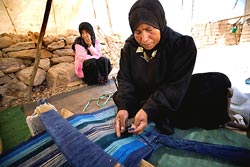 Week 3 began with a great tour along the Kings' Highway (SW Jordan) in air-conditioned buses. Breakfast was at 7 a.m. on Sunday, July 6, with departure at 8 a.m. Everyone had to make lunches to take along and there was quite a line-up to get the job done. Cucumbers and cheese, buns and flatbread, flew into plastic bags for the journey. After roll call, the two buses were off to the first location, Mt. Nebo.
Week 3 began with a great tour along the Kings' Highway (SW Jordan) in air-conditioned buses. Breakfast was at 7 a.m. on Sunday, July 6, with departure at 8 a.m. Everyone had to make lunches to take along and there was quite a line-up to get the job done. Cucumbers and cheese, buns and flatbread, flew into plastic bags for the journey. After roll call, the two buses were off to the first location, Mt. Nebo.
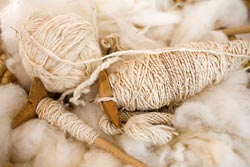 The sky here is usually blue and cloudless, but for our journey to Mt. Nebo and the other sites on Sunday, there were clouds; you could not see forever. The Jordan Valley was somewhat obscured and the church at Mt. Nebo was undergoing renovation, but all the same, it was a thrill to walk to the lookout point , to stand where many famous pilgrims have come, including Pope John Paul, and for a moment, to be part of biblical history.
The sky here is usually blue and cloudless, but for our journey to Mt. Nebo and the other sites on Sunday, there were clouds; you could not see forever. The Jordan Valley was somewhat obscured and the church at Mt. Nebo was undergoing renovation, but all the same, it was a thrill to walk to the lookout point , to stand where many famous pilgrims have come, including Pope John Paul, and for a moment, to be part of biblical history.
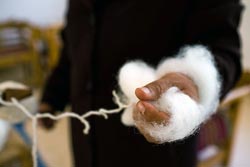 The second site was the town of Madaba and a visit to the Archaeological Park where we saw many of the restored mosaics, including Aphrodite spanking Cupid. Larry Herr and Rob Saley had an interesting time deciphering the Greek on one of the mosaics.
The second site was the town of Madaba and a visit to the Archaeological Park where we saw many of the restored mosaics, including Aphrodite spanking Cupid. Larry Herr and Rob Saley had an interesting time deciphering the Greek on one of the mosaics.
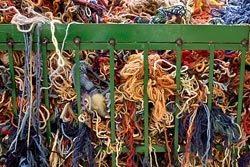 The third stop was at the Bani Hamida weavers' co-op. This is a women's entrepreneurial endeavor started by Pat Salt to enable local women to improve their living situation - helping to provide better education and better medical care for their families.
The third stop was at the Bani Hamida weavers' co-op. This is a women's entrepreneurial endeavor started by Pat Salt to enable local women to improve their living situation - helping to provide better education and better medical care for their families.
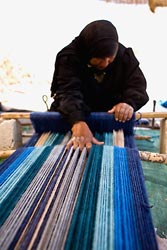 Our stay here was not long, but there was a line-up to purchase wool baskets, carpets and other woven crafts. One young woman from the co-op was demonstrating how she rolled the wool into little felt balls for eyes or grapes to use in the weaving. Dana Waters, Merlè Otto-Steenbergen, and the three young Bates girls--Becky, Jessica, and Elizabeth-- all tried their hands at dipping the wool into warm water and then rolling it into balls. Jordanian hospitality dictates that tea must be served, and so we were all treated to glasses of hot, sweet tea with mint. After all the purchases were made, we were off to Machaerus, where one of Herod's palaces once stood.
Our stay here was not long, but there was a line-up to purchase wool baskets, carpets and other woven crafts. One young woman from the co-op was demonstrating how she rolled the wool into little felt balls for eyes or grapes to use in the weaving. Dana Waters, Merlè Otto-Steenbergen, and the three young Bates girls--Becky, Jessica, and Elizabeth-- all tried their hands at dipping the wool into warm water and then rolling it into balls. Jordanian hospitality dictates that tea must be served, and so we were all treated to glasses of hot, sweet tea with mint. After all the purchases were made, we were off to Machaerus, where one of Herod's palaces once stood.
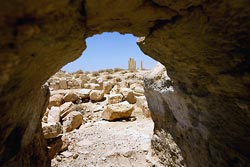 Machaerus was our lunch stop. Tomatoes and watermelon were added to the lunches we had made, and Stefanie Elkins provided some delightful sesame cookies. While some of the sojourners rested under the meager shade, the more adventurous assaulted the "mountain" to the former site of Herod's Palace, passing caves which had probably served as cisterns and speculating about bones discovered on the way down.
Machaerus was our lunch stop. Tomatoes and watermelon were added to the lunches we had made, and Stefanie Elkins provided some delightful sesame cookies. While some of the sojourners rested under the meager shade, the more adventurous assaulted the "mountain" to the former site of Herod's Palace, passing caves which had probably served as cisterns and speculating about bones discovered on the way down.
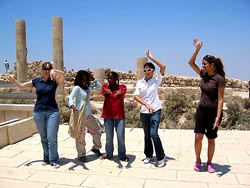 Some took a more direct route ascending and descending, but even the ones who took a more circuitous route all ended up safely at the buses. Some of the young women who climbed to the top reenacted Salome's dance which had resulted in the beheading of John the Baptist. These adventurous and lithe young women still had the energy after their climb: Bethany Melendy, Kemi Adedokun, Evelyna Laurie, Natasha Plantak, and Megan Channer.
Some took a more direct route ascending and descending, but even the ones who took a more circuitous route all ended up safely at the buses. Some of the young women who climbed to the top reenacted Salome's dance which had resulted in the beheading of John the Baptist. These adventurous and lithe young women still had the energy after their climb: Bethany Melendy, Kemi Adedokun, Evelyna Laurie, Natasha Plantak, and Megan Channer.
Passing through Dhiban, we reached Lahun, an Iron 1/Iron 2 site sitting on the escarpment overlooking the Wadi Mujib, the Grand Canyon of the Jordan. This site of Lahun had been excavated by Denyse Homès-Fredericq and her team of Belgian excavators. The Wadi Mujib is an impressive sight. Photo opportunities were not missed here - among them, several apparently daredevil poses by Teagen Johnson, Jimmy Arsenault, Darren Heslop, and Rebekah Gauthier.
The last stop before returning to our home base was Umm Ar-Rasas. This was the site of a large monastic church and settlement with several preserved mosaics. Although some were not open for viewing, we were free to explore the ruins, observing the walls and amazing arches that had withstood the centuries. Our bus driver had informed us that "rassus" was probably the metal, lead. Home again in time for supper and preparation for that 4:15 a.m. rising bell.
On Monday evening we had a special guest lecturer, Dr. Barbara Porter, director of ACOR (American Center of Oriental Research). She spoke about Byzantine Petra, especially the Petra Church, the Blue Chapel, and the Ridge Church, all in anticipation of our Petra tour at the end of the week.
Week 3 marks half season at the dig which culminates in one of the major highlights of the dig--the trip to Petra. This is also the time when we welcome new people and say goodbye to some others. Welcome to two new groups that joined us this week:
The Wesley Theological Seminary Group (working with David Hopkins)--Patricia Abell, Heather Hartmann, William Hawkins, Julia Piper, Frankie and Kerry Revell, Rebecca Richards, and Martha Rose. They are working in Field L.
The Polish Group (working with Elzbieta Dubis) - Ewa and Marzena Daszewska, Grazyna Swoboda-Wilk, and Remigiusz Wilk. They are working in Field K (the Dolmen).
Welcome as well to Jim Fisher, Associate Registrar at Walla Walla University, who also joined us this week.
July 8 was a special day for Larry Murrin, our "computer guy." He is the man who sets up the computers and keeps them humming. Also, if it was not for Larry, there would be no e-mails home. July 8 was Larry's birthday, so of course we had ice cream, but Larry had planned a special date for that night, and he was kind enough to include as many of us as wanted to attend. It was a date with Diana Krall. The venue was an outdoor stage at the Citadel, hilltop center of ancient Amman. It was a glorious evening for a concert-a warm wind blowing, spotlights on the Umayyad Palace, the lights of Amman down below, and spontaneous fireworks (just for Larry!). What a spectacular venue for the jazz pianist/singer and her three excellent musicians. The concert was absolutely amazing-almost non-stop singing and playing. One humorous incident that occurred at the beginning of the concert was an announcement that began, "Ladies and gentlemen, we have an emergency situ..." People sat quietly wondering what this was all about, but it was later clarified by the king's representative who introduced Diana Krall. He said, "In case of an emergency, please follow the directions of the ushers."
On Wednesdays at supper time, the money changer arrives. This is a convenience for people who need Jordanian dinars to make purchases. In anticipation of the trip to Petra, it was a very busy evening for him.
Kudos go this week to Bethany Reiswig, a square supervisor in Field B, and her crew - Rachelle Mutch, Stephen Huffaker, and their Jordanian workers, who moved 504 guffahs full of soil before second breakfast. That's about 5 cubic meters of earth in about four hours!
A camel came to the tell on Wednesday, courtesy of one of the Jordanian workers, and Jeanne DelColle had an exciting ride. There are pictures to prove it!
One of the more challenging aspects of our work at the tell this week was the realignment of the squares in our new excavation fields, Field M and Field N. They were realigned by Matt Vincent using new GPS technology. This means that any subsequent field that opens can be lined up perfectly (theoretically within a centimeter) with all the other squares according to true north. The original alignment was done the old fashion way by surveyors in the early 1980s and they are off true north by 2-3 degrees.
It was fitting that the Wednesday night movie was Indiana Jones and the Last Crusade, which of course, features Petra. Tuesday and Thursday evenings there were Learning Stations. The presenters on Tuesday were Julie Cormack (Lithics) and Gloria London (Ceramics). Thursday's Learning Station was on Processing and Documentation. This involved several specialists: Denise Herr on pottery, Suha Huffaker on objects, Rhonda Root and Stefanie Elkins on artist renditions, Darren Heslop on object photography and Larry Murrin and Matt Vincent on computerization.
On Friday morning, work finished even earlier than usual so that we could prepare for our trip to Petra. We boarded A/C buses and were on the road by 2 p.m. The three-and-a-half-hour drive across the desert was barren but as we descended into the Wadi Mousa (the Valley of Moses), the landscape suddenly changed. There were more trees and more colors. And then there was Petra, a town built into the rock hills. As we pulled up to our hotel, the Crowne Plaza Resort, there were exclamations of "Wow! Is this where we are staying?" Our home for Friday and Saturday nights was a resort with a view of some of the Petra tombs, air-conditioned rooms, and a swimming pool. There were breakfast and supper buffets with food that we hadn't seen for quite some time.
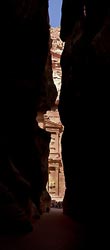 Awesome is a word that has become almost meaningless, but in the true sense of the word, it absolutely applies to Petra; amazing facades carved into mountains, colors that designers cannot define, tombs, and churches with absolutely beautiful mosaics are some of the wonders. Some people managed to walk down the Siq and get to the Treasury before supper on Friday night. Others left right after breakfast on Saturday morning and spent the day exploring the sights. Some, like Mary Boyd and Alice Holinger, managed a camel ride; others, like Carolyn Waldron, opted for a donkey.
Awesome is a word that has become almost meaningless, but in the true sense of the word, it absolutely applies to Petra; amazing facades carved into mountains, colors that designers cannot define, tombs, and churches with absolutely beautiful mosaics are some of the wonders. Some people managed to walk down the Siq and get to the Treasury before supper on Friday night. Others left right after breakfast on Saturday morning and spent the day exploring the sights. Some, like Mary Boyd and Alice Holinger, managed a camel ride; others, like Carolyn Waldron, opted for a donkey.
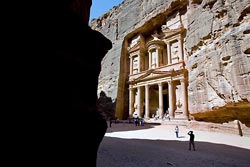 |
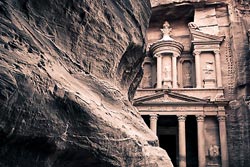 |
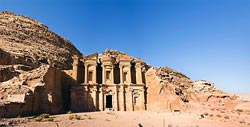 |
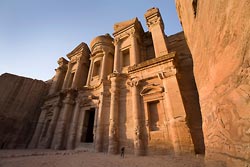 |
Kent Bramlett made his tour of Petra a personal challenge, "just to make sure [I] hadn't gone soft in mind or body." Kent performed an amazing 10-hour, Petra-in-a-day feat by making it to five major hill-top sites: Jebel Haroun , 2 hours, 10 minutes from entry ; Umm el-Biyara; ed-Deir (monastery), 20 minutes from the bridge; el-Habis; the High Place, 20 minutes to the very top.
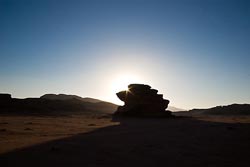 A group of young women led by Autumn Whiteway spent Saturday night in a Bedouin camp in Wadi Rum, about one and a half hours from Petra. The others involved in this escapade were Kemi Adedokun, Jennifer Ayles, Jennifer Bernhardt, Lynne Fulton, Jenna Hurtubise, Evelyna Laurie, Elinor Matthews, and Bethany Melendy.
A group of young women led by Autumn Whiteway spent Saturday night in a Bedouin camp in Wadi Rum, about one and a half hours from Petra. The others involved in this escapade were Kemi Adedokun, Jennifer Ayles, Jennifer Bernhardt, Lynne Fulton, Jenna Hurtubise, Evelyna Laurie, Elinor Matthews, and Bethany Melendy.
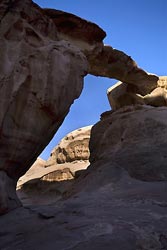 Another group also travelled to Wadi Rum to enjoy the desert sunset and night sky, recalling all the romance of Lawrence of Arabia. This group numbered thirteen: Denise and Larry Herr, Stephanie and Garrick Herr, Dana Waters, Rob Saley, Gary and Suha Huffaker, Brenda and Michael Adams, Anneliese Weiss, Julia Piper, and Merlè Otto-Steenbergen. Most of the people enjoyed the desert ride from the open backs of pickup trucks--an unforgettable experience. Sitting quietly as the sun set and the stars came out was almost a mystical experience. When the two groups met on the desert, there were a few moments of desert frolicking. Elinor Matthews started things off by some spontaneous sand rolling and was followed by Jennifer Ayles. Garrick Herr demonstrated his sand boarding (minus a board) and rolling techniques with no mishaps. There is even video footage of some of these antics.
Another group also travelled to Wadi Rum to enjoy the desert sunset and night sky, recalling all the romance of Lawrence of Arabia. This group numbered thirteen: Denise and Larry Herr, Stephanie and Garrick Herr, Dana Waters, Rob Saley, Gary and Suha Huffaker, Brenda and Michael Adams, Anneliese Weiss, Julia Piper, and Merlè Otto-Steenbergen. Most of the people enjoyed the desert ride from the open backs of pickup trucks--an unforgettable experience. Sitting quietly as the sun set and the stars came out was almost a mystical experience. When the two groups met on the desert, there were a few moments of desert frolicking. Elinor Matthews started things off by some spontaneous sand rolling and was followed by Jennifer Ayles. Garrick Herr demonstrated his sand boarding (minus a board) and rolling techniques with no mishaps. There is even video footage of some of these antics.
Sunday morning was the last opportunity to see Petra. Denise Herr and Dana Waters sang "Dona Nobis Pacem" to test out the acoustics in the Urn Tomb, and Bethany Reiswig and Rachelle Mutch performed the same test with "Silent Night."
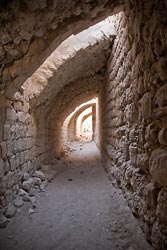 On the way back from Petra, our buses stopped at Qal'at ash-Shawbak, a 12th century Crusader castle that stands alone on a hill in the desert. The imagination can supply many of the details of battles here.
On the way back from Petra, our buses stopped at Qal'at ash-Shawbak, a 12th century Crusader castle that stands alone on a hill in the desert. The imagination can supply many of the details of battles here.
One more stop at the Dolmen Service Center for a bathroom break and munchies, and then we were homeward bound for the UNRWA Amman Training College. What a fantastic weekend!
[ Photos courtesy David Sherwin, Marc Ullom, Sharon Prest, Dana Waters (Salome Dancers). ]